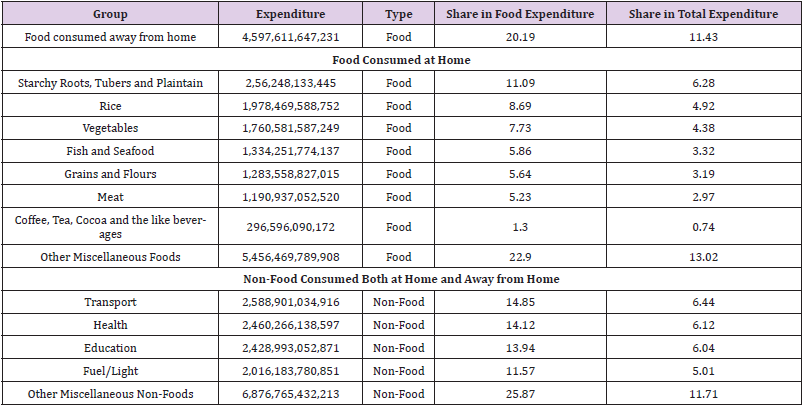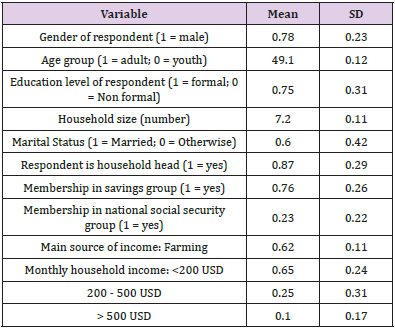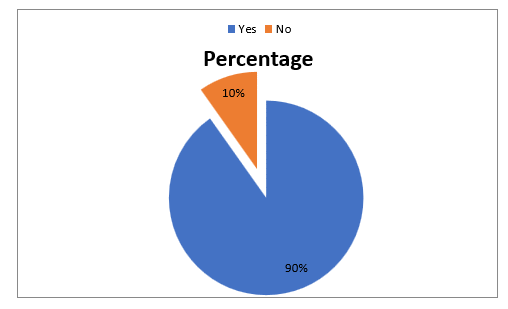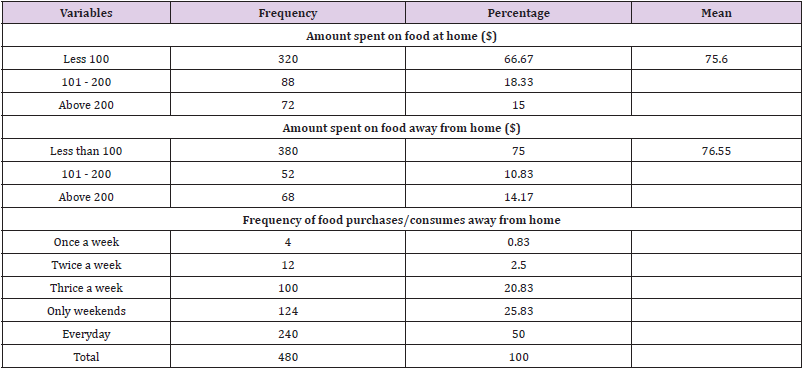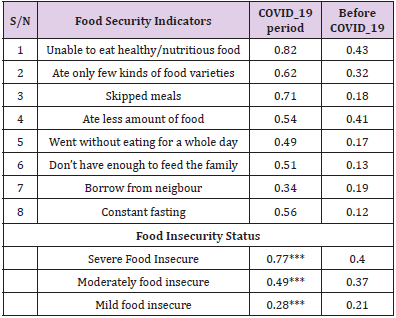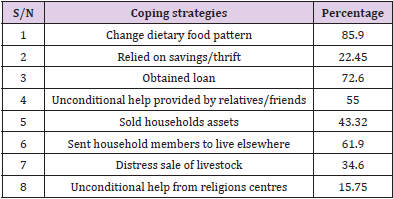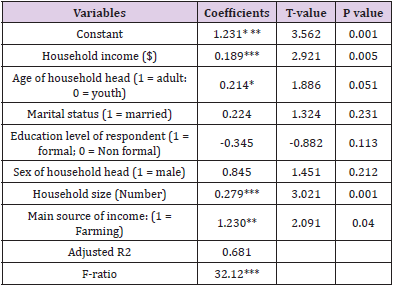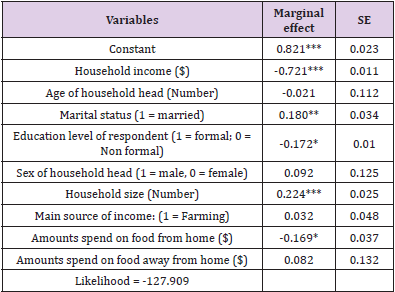ABSTRACT
The study accessed the determinant of food expenditure pattern among rural households in Nigeria during COVID_19 pandemics. The specific objectives are to estimate the amount spent weekly on food and determine the factors affecting amount spent of food in the household. Simple random sampling technique was used to select 480 rural households across three (3) state of southwest geopolitical zones in Nigeria. A well-structured questionnaire was used to collect information on age, marital status, amount spent on foods among the farming households in the study area. Descriptive statistic was used to estimate the mean age of the respondents and estimate the amount spent on food while Ordinary Least Square (OLS) regression was used to determine the factors affecting the amount spent on food in the household of the respondents in the study area. The result of descriptive statistics revealed that 62.0 percent of the respondents are married, 72.0 percent were educated with mean age, household size and monthly income estimated at 47 years, 7 persons and less than $200 respectively. Majority (66.67 percent) of the respondents spent less than $100.00 on food with mean amount spent on food at home and away from home estimated at $75.60 and $76.55 respectively. OLS regression revealed that household income (p<0.01), age of the household head (p<0.1), household size (p<0.01) and occupation (p<0.05) have positively significantly influence on food expenditure of the households. This research concluded that household income, household size and age of household head had a significant effect on food expenditure. The study recommended that policy attention should be focused on the price control system on food to be more affordable to rural dwellers.
Keywords: Data; Expenditure; Ordinary Least Square; Regression
Abbreviations: OLS: Ordinary Least Square; WHO: World Health Organisation; FGN: Federal Government of Nigeria; PAYE: Pay as You Earn; CBN: Central Bank of Nigeria; HIES: Household Income and Expenditure Surveys
Introduction
The provision of food within the households has always been a challenge facing mankind. Globally, around 820 million people face hunger daily and more than two billion people lack vital micronutrients, affecting their health and life expectancy [1]. The root causes of food insecurity are complex and multidimensional. They are linked to a range of closely related factors, such as poverty, low access to basic social services, and inadequacy of some public policies (Abdullah et al., 2019). Households have varying degrees of spending capacity which influences their spending patterns. According to Engel’s law of expenditure, proportion of expenditure spent on food is inversely related to total income [2]. According to Njimanted [3] the nature and patterns of food expenditure reflect the socio-economic characteristics of households. A household’s relative expenditure on food is a reliable indicator of vulnerability. It describes household’s capacity to cope with price increases, as well as their ability to remain productive by investing in health services, education, tools and other productive assets for its members. Households spending in excess of 65% of their total expenditure on food are clearly vulnerable in this regard as such a high percentage suggests that the household is forced to choose between meeting their food and non-food needs or reduce consumption of one or both below their needs [2]. Approximately 73 million people in Nigeria were facing worse levels of acute food insecurity and in need of assistance [4].
This bleak global and regional food insecurity picture will be compounded by the unfolding effects of the Coronavirus Disease 19 (COVID-19) pandemic. First reported in Hubei province of China in December 2019 [5], the virus rapidly spread throughout the world, and the World Health Organisation (WHO) declared it a global pandemic in March 2020 [4]. The disease has since become an unprecedented public health crisis that has led to economic and social crises. In West Africa region, the first case of COVID-19 was officially reported in Nigeria on February 27th, 2020, and the disease has since continued to spread in the region with new infections reported every day. Consistent with World Health Organization (WHO) guidelines and the global practice, West Africa governments instituted various restrictions to contain the spread of the disease within their boundaries. The measures included movement restrictions, border closures, social distancing, quarantine, and closure of non-essential services. Suffice to say, the enforcement of these stringent measures has inadvertently disrupted peoples’ way of life with significant ramifications on food security and the economy. This is particularly true in West Africa, a region already struggling with widespread poverty, hunger, and malnutrition due to multiple shocks. Reports show that the region will face disruptions in three ways; the loss of income for especially people working in the informal sector who often survive on daily hand-to-mouth wages, reduction in income from remittances, and the disruption of food systems [6], thereby creating strong tensions and food security risks. Other reported factors considered to amplify the situation in Nigeria include a large share of informal workers with no opportunity to work from home, less diversified income streams, and weak health systems.
Besides, the weak or non-existent state welfare systems in Africa [7] to shield households against loss of income will spell dire consequences to households on access to food, adversely affecting their nutritional status. McKibbin and Fernando [8] opine those infectious diseases of a pandemic nature can affect households, governments, and businesses through among other ways, increased business costs, increased public health care expenditure, and changes in labour supply due to mortality and morbidity. COVID-19 related restrictions in Nigeria have obstructed all stages of the food supply chain, including production, distribution, processing, and consumption [9], and damage of perishable agricultural commodities such as meat and vegetables [7]. In contexts where shocks lead to food gluts or shortages, food prices are bound to increase, with prices of the most nutritious foods likely to experience the highest spike. WHO (2020) report food price increases of 8 to 10% in West Africa region between April 2019 and April 2020, following the start of the COVID-19 pandemic. Fresh produce such as vegetables, meat, and fish recorded the highest increases, driven mainly by shortages related to disruptions in the supply chain. While various studies have examined potential impacts of the pandemic on global and national economic indicators such as global poverty, government expenditures, GDP growth, budget deficits, employment and food expenditure [10,11], there is limited information on how the pandemic, and associated lockdown policies, is affecting individuals at the household level especially of their food expenditure pattern. Economic effects of such a pandemic disproportionately impact members of the society, depending on their socio-economic status, livelihood strategies, access to markets, thus it is important to understand the household level impacts and support mechanisms that can be enhanced to ensure income smoothing.
Ozili [12] studied the impacts of COVID-19 and related restrictions on smallholders in India and reported a large degree of heterogeneity in the impacts of COVID-19 responses on agricultural activity, income, and food security. We also intended adding to the growing body of knowledge on the COVID-19 pandemic by examining its implications for household food expenditure pattern in Nigeria.
The following specific objectives were addressed:
1. Describe the socioeconomic characteristics of rural farming households in Nigeria
2. Estimate the amount spent on food within and away from households
3. Ascertain the frequency of time food purchased/consumed away from home
4. Determinant of food expenditure pattern of rural farming households in Nigeria
5. Highlight the policy responses been put in place to alleviate the effects of the pandemic on household’s food expenditure pattern. Results are based on a rapid assessment and provide empirical analysis that complements existing knowledge to guide policy discussions on food expenditure implications and coping measures during the early days of the COVID-19 pandemic and inform decision-making on preserving the livelihoods of households most at risk due to the pandemic.
Household Food Expenditure Pattern in Nigeria (Before COVID-19)
In determining living standards, income and consumption are the most popular approaches. Income refers to earnings from productive activities and current transfers. Measuring consumption over a week or month provides an indication of a household’s consumption habits over a year because it has a smooth flow to it in order words it is steady. The expenditure pattern of a household is the combination of qualities, quantities, acts and tendencies characterizing a community or a human group’s use of resources for survival, comfort and enjoyment. Of course, the type of food and non-food items consumed, vary from region to region. The expenditure patterns within a household normally contribute greatly to the social and economic policy of the country. For a developing country like Nigeria, the household’s expenditure pattern is skewed towards food i.e., food is higher than the nonfood items. In most developed countries, it is the opposite, where the household’s expenditure pattern is skewed towards non-food items. The more developed a society becomes, the less it spends on food and the more it spends on nonfood items. Lagos is a clear indication of a state with an emerging economy.
Table 1 showed the households expenditure pattern in 2019. At the national level the total household expenditure on food and nonfood for 2019 was ₦40,207,388,459,367 (₦21,620,601,543,613.90 in 2009/10). Of this total, 56.65% (60.2% in 2009/10) of total household expenditure in 2019 was spent on food with the balance of about 43.35% (39.8 % in 2009/10) spent on non- food items. Food consumed outside the home, followed by transportation costs and starchy roots, tubers and plantains were responsible for the largest proportion of household expenditure representing a combined 24.16 percent of total household expenditure in 2019. Further analysis of food expenditure by households in 2019 reveals that various foods consumed outside the home, starchy roots, tubers and plantains, rice, vegetables, fish and sea food, grains and flours in that order were the top food items households spent on in 2019 accounting for a combined 59.19% of food expenditure and 33.53% of total household expenditure on food and 24.8% of total household expenditure. Household expenditure on nonfood items on the other hand were directed as aforementioned mostly at transport, health, education and services (which includes information technology and communication equipment as well as things like insurance, financial services and so on), rent and fuel and light, accounting for a combined 79.40% of non-food expenditure.
COVID_19 in Nigeria and Policy Implication
The first case of COVID-19 in Nigeria was officially reported on February 27th, 2020, and the disease has since continued to spread with new infections reported every day. Consistent with WHO guidelines and the global practice, West Africa governments especially Nigeria instituted various restrictions to contain the spread of the disease within their boundaries. These measures comprised country-wide partial lockdowns and curfews to restrict the movement of people, suspension of international passenger flights, a ban on public gatherings, closure of all learning institutions, hotels, restaurants, and places of worship. In Nigeria, interstate travels were also restricted throughout the country, with citizen only allowed to leave their state in emergency purposes [13]. To cushion their citizens against the adverse economic effects of the pandemic, the governments of Nigeria announced various policy guidelines and financial stimulus packages. The Federal Government of Nigeria (FGN) announced a reduction of the income tax rate (Pay As You Earn -PAYE), reduction of resident income tax (Corporation Tax), reduction of the turnover tax rate, reduction in Value Added Tax and provision of relief package for state governments. Also, in around June 2020, the FGN further announced a post-COVID-19 economic stimulus package to support private businesses that have been hit by the pandemic. The package is aimed at providing credit guarantees, loans to small businesses, and help prop up tourist facilities. The Central Bank of Nigeria (CBN), in its Monetary Policy made use of credit relief measures to mitigate the adverse effects of the COVID-19 pandemic, ensuring financial sector stability and reduction of central bank lending rate during this pandemic period. FGN also announced that they would provide food relief package and stipends to vulnerable workers, particularly those whose daily activities were affected by the lockdown. While these measures will to some extent mitigate the economic impacts of COVID-19 on the citizens of these two countries, they are in no way a panacea for their food expenditure pattern. Ozili [12] suggest that social assistance programmed like direct cash and in-kind transfers to households and waiver of utility fees could have yielded more favorable outcomes to such households, in particular, the wage earners whose earning has been affected by restrictions. Besides, the relief measures came into effect when people had already lost their sources of income, and social protection measures were hardly implemented due to logistical challenges, hence amounting to minimal relief.
Studies on food consumption and expenditure have often been the subject of research in the developed and developing world. They provide important inputs into food and related nutritional policy initiatives, by providing estimates of how food consumption is likely to change with changes in prices, incomes and taxation. The national expenditure data in Nigeria has shown an increase in proportion of food expenditure to the total households’ expenditure [14]. This as indicated by the Central Bank of Nigeria was at the rate of 70% [15] leaving many Nigerians in the dilemma of having neither the means to produce food nor the money to buy food. All these are clear evidence that a great number of people regularly are joining the train of those who are hungry, starving and malnourished suggesting that the country is characterized by high level of food insecurity with Kogi and Kwara states not exempted. National food expenditure data show that almost two thirds of total expenditure in 2004 was on food. This food share had risen by about 10% points by 2010 but dropped during the period 2004-2006. In the subsequent four-year period, 2007-2010, a further drop of 5% points took place. The figures were 63.4%, 74.1%, 72.8% and 63.6% for 2007, 2008, 2009 and 2010 respectively.
The percentage of a household’s total expenditure on food gives an indication of their vulnerability to food insecurity in the future. In the case of a job loss, natural disaster, disease onset or price policy reform, a household will be particularly at risk if over 70 percent of the income is spent on food [14]. Many people thought that food insecurity is increasingly concentrated in particular regions or groups within Nigeria and thus there is a great need for sub-national information. Household Income and Expenditure Surveys (HIES) are used to obtain information on a variety of specific conditions, experiences and behaviours indicating the severity of the condition. They are sources of policy relevant measures allowing monitoring and targeting of regional or national prevalence of food insecurity. But data collection and computation costs are high in terms of time, financial resources and technical skills required and cannot determine inequalities of access to food between individuals within a household [2]. The household is only examined at the time of interview so changes may well occur, and estimates may be biased through systematic non- sampling errors. In addition, social desirability problems may occur when respondents do not want to look bad in front of interviewers [15].
Methods
Data
The study was carried out in selected States of Southwestern Nigeria. Southwestern Nigeria comprises six states which are Lagos, Ogun, Oyo, Osun, Ondo and Ekiti. The Southwest lies between latitude 50N and 90N of the equator and longitudes 2.50 and 60N east of the Greenwich Meridan. It is bounded in the East by Delta State, the Republic of Benin in the West, Kwara and Kogi State in the North and by the Atlantic Ocean in the south. The major occupation in the States is farming in which Maize, Cassava, Rice, Yam, Oil palm, Cocoa, Timber are produced enormously. The vegetation pattern of the states is of rainforest in the south and guinea savannah in the north. Figure 1 shows the position of the study area in the map of Nigeria.
Sampling Techniques and Data Analysis
Multistage sampling procedure was used to select 480 rural farming households across the selected states (Oyo, Ekiti and Ogun) in Nigeria. First stage involved the selection of two (2) Zones from each states making 6 zones. Second stage involved random selection of two (2) blocks from each of the six (6) ADP zones respectively making 12 blocks. Stage three involved random selection of four (4) cells from each of the 12 blocks making 48 cells. While the last stage involved random selection of ten (10) rural households from each of the 48 cells making 480 rural farming households. Primary data were collected using structured interview guide. Descriptive statistics including frequencies, means, standard deviations, and t-test were used to highlight the socio-economic characteristics of the respondents, food expenditure pattern of the respondents, food security indicator before and during COVID_19 as well as the coping strategies adopted. Ordinary lease square regression was used to estimate the determinant of food expenditure pattern of the respondents while Tobit regression model was used to estimate the factors determining the food insecurity situation of the respondents during COVID-19 crisis.
Results and Discussion
Socio-Economic Characteristics of Respondents and Whether COVID_19 Affect their Household Food Expenditure Pattern
Table 2 revealed the socioeconomic characteristics such as Age, Marital status, Education, Farm size, Religion and Household size of the respondents in the study area. The study showed that more than two-thirds of the respondents were male and constitute the households in the study area. Also, the mean age of the respondents was estimated at 49 years. This was in line with Davis (2019) who reported that the mean age of the respondents in rural areas of Nigeria was estimated to be 47 - 50 years. In terms of marital and employment status of the respondents in the study area, 60.00 percent of the respondents were married while 62.0 percent chose farming as their main source of livelihood activities. Majority (65.00 percent) of the respondents earned less than $200.00 while about two-thirds (76.0 percent) of them are membership of saving groups. Furthermore, respondents were asked whether the COVID-19 pandemic had affected their household’s food expenditure pattern. Their responses are summarized in Figure 2. Approximately 90.0 percent of the respondents asserted that the pandemic had affected their regular household’s food expenditure pattern. This was in line with the widespread perceptions about the negative impacts of the COVID-19 crisis on jobs and incomes which at long run will have a complicated and negative influence on amount of income and money spent on food within and outside the households of the respondents.
Table 2: Summary statistics of the socio-economic characteristics of the respondents (₦408= $1) n = 480.
Food Expenditure Pattern of Rural Farming Households During COVID_19
The distribution of respondents based on amount spend on food at home, away from home and frequency of food purchased/ consumed away from home were presented in Table 3. Majority (66.67 percent) of the respondents spent less than $100.00 on food with mean amount spent on food at home and away from home estimated at $75.60 and $76.55 respectively. The categorization of respondents based on frequency of food purchased/consumed away from home revealed that majority (75.83 percent) consumes/ purchases food away from home either on daily basis or weekends as against about 1.0 percent of the respondents that consumes once a week.
Table 3: Distribution of Food Expenditure Pattern of the households during COVID_19 in the study area (₦408=$1) n = 480.
Implications of the COVID-19 Pandemic on Food Security Status of Rural Farming Households
Table 4 revealed the result of t-test of significant difference between the food security situations of the respondents before and during the COVID_19 pandemic. The result revealed that food security of the respondents has worsened during the period of pandemic compared to normal period. Majority (above 60.0 percent) of the respondents were unable to eat healthy/nutritious food, ate only few kinds of food and skipped meals whereas less that 50.0 percent of the respondents experienced these food insecurity situations before COVID_19. Almost 50.0 percent of the respondents went without eating for a whole day and no enough food to feed the family during COVID_19 while few percent (less than 20.0 percent) experienced these food insecurity scenario during normal period. The result for three food insecurity measures constructed from food security indicator items were also presented in Table 4. Compared food insecurity status during COVID_19 and normal period, the findings reveal that the number of food insecure households increased by 77.0 percent and 40.0 percent in the two period respectively. Likewise, comparing moderately food insecure and severely insecure for the households in the study area before and during COVID_19 showed that the value increased by 37.0 percent and 49.0 percent respectively for moderate food insecure, 28.0 percent and 21.0 percent for severely insecure respectively for households during COVID_19 and before COVID_19. This may be due to several COVID-19 induced disruptions, such as income shocks which limited disposable amount spend on food, as well as disruptions in food supply chains, resulting in possible food shortages and higher food prices (FAO, 2020).
Table 4: Distribution of Respondents based on Food security situation before and during the COVID_19 period (%).
Coping Strategies Against Food Insecurity by Rural Farming Households During COVID_19
The various coping strategies adopted by the households to mitigate their food insecurity situation during COVID_19 was presented in Table 5. Majority (85.90 percent) of the respondents change dietary food pattern involuntary to mitigate the food insecurity level during COVID_19, 72.60 percent of them obtained loan for feed from any available financial source, 55.00 percent, 61.90 percent and 34.60 percent seek help from relatives/friends, sent some of their household members to live with someone and engaged in distress sale of livestock respectively to mitigate the effect of COVID_19 on their households consumption pattern in the study area.
Table 5: Distribution of Respondents based of coping strategies adopted against food insecurity during COVID_19 (%).
Determinants of Food Expenditure in Rural Farming households of the Respondents
The data on the determinants of household food expenditure was analyzed using double-logarithmic regression equation as lead equation which was chosen based on theoretical and statistical criteria. Food expenditure was the dependent variable while the explanatory variables included age of household head, marital status of household head, level of education, sex, household size, household income and household composition. The result of the analysis is presented in Table 6. The result of the regression analysis revealed that household income (p<0.01), age of the household age (p<0.1), household size (p<0.01) and occupation (p<0.05) were positively significantly have influenced on food expenditure of the households. This result shows that household will spend more on food with rising household income, household size and presence of dependents and risk group (infants and pregnant women). In addition, with relatively low income and high household size in the study area, this result calls attention to the need for intervening policy with respect to the nutritional status of the target population especially considering the high cost of food items in the urban communities. The result was in line with Dankwa, et al. [16] who reported that effect of household size on their expenditure pattern has a combination of two effects- ‘a specific effect’ and an ‘income effect’. The adjusted R2, measures the ability of the explanatory variables to explain all the variation in the dependent variable for the equation is 0.681 which shows that the combine effect of the independent variables accounted for 68.1 percent of the variations in the household expenditure on food items. The F-ratio provides an overall test of significance of the whole function of the regression line. This test shows that F-ratio is statistically significant at 1 percent level of significance.
Table 6: Determinants of Food Expenditure in Rural Farming households of the respondents (₦408=$1) n = 480.
Note: ***, **, and * represent 1%, 5%, and 10% significance level, respectively.
Maximum Likelihood Estimate of Tobit Regression of Determinant of Food Insecurity Status of the Respondents
The result of Tobit regression showing the effects of selected socioeconomic characteristics of the respondents, amount spend on food at home and away from home on the food insecurity status was presented in Table 7. The statistically significant variables affecting food insecurity status were household income (p<0.01), marital status (p<0.05), educational level of household head (p<0.1), household size (p<0.01) and amount spend on food at home (p<0.01). The negative parameter estimates of household income, educational level of household head and amount spend on food at home revealed that there exist an inversely relationship between the variables and food insecurity status of the rural farming households. This further explained that these variables tend to lower the food insecurity status of the respondents. This was in conformity with Arndt et al. (2020) who reported that lockdown policies will jeopardize the food insecurity status of low-income households because their income will determine the amount spend on food at home and level of food consumption. Furthermore, the positive parameter estimates of marital status and household size denoted that there was positive correlation between these variables and food insecurity status of the respondents. This shows that the higher these variables the more the households of the respondents tend to more insecure [17-19].
Table 7: Maximum likelihood Estimate of Tobit Regression of Rural Farming households in the study area (₦408=$1) n = 480.
Note: ***, **, and * represent 1%, 5%, and 10% significance level, respectively.
Conclusion and Recommendation
This study assessed the implications of COVID-19 on households’ food security and expenditure pattern in Nigeria. Data were collected from rural households in Southwestern geopolitical zones of Nigeria. The finding concluded that majority of the respondents are young, married with average household size of 7 persons and estimated monthly income of less than $200.00. Also, majority of the respondents’ purchases/consumes food away from home on daily basis with estimated weekly expenditure of $75.60. Also, the results show evidence of worsening food security of respondents in the study area during the COVID-19 period compared to period before it. This is attributed to the loss or reduction in income, reduced access to markets due to travel restrictions and low purchasing power. It was observed that household income, tribe, household size and occupation of household head had a significant effect on food expenditure. Therefore, there is a suspected existence of food insecurity and vulnerability to poverty in the study area which could be as a result of high cost of food items.
Recommendation
Based on the foregoing, the study recommends that
1. With relatively low income and high household size in the study area, this result calls attention to the need for intervening policy with respect to the nutritional status of the target population especially considering the high cost of food items in the communities.
2. Better policy attention should be focused on the price control system to food with high nutritional value to be more affordable to rural dwellers. Supportive efforts such as improvement in inter-state transport and road network will ameliorate spatial differential prices.
3. Provision of subsidies on the food items mostly consumed by infants and pregnant should be explored by government as part of the health and nutrition policy for these groups of citizens.
4. More studies on food expenditure analysis should focus on urban communities as there are likely evidence of food insecurity and nutritional deficiencies in these communities as obtained in the rural areas
5. Also, the government needs to implement structural changes in social security schemes that will consider packages that are responsive to members’ needs during such crises, as an immediate fall-back position.
6. Promoting and harnessing the savings and borrowing capacity, especially for low-income earners and rural households would provide opportunities for borrowing and restoring businesses and livelihoods after a crisis like COVID_19.
7. Lastly, mechanisms to ensure the survival of food supply chains, particularly those making available nutrient-dense food are key.
References
- (2019) FAO IFAD UNICEF WFP & WHO. The State of Food Security and Nutrition in the World 2019. Safeguarding against economic slowdowns and downturns. Rome: FAO. Licence: CC BY-NC-SA 3.0 IGO.
- Olayemi JK (2004) Principle of microeconomics for applied economic analysis. SICO Publisher, Ibadan.
- Njimanted GF (2006) Econometric model of poverty in Cameroon: A system estimation approach. International Review of Business Research 2: 30-46.
- (2020) USAID. Food assistance fact sheet Kenya.
- Singhal T (2020) A review of coronavirus disease-2019 (COVID-19). Indian Journal of Pediatrics 87: 281-286.
- UN-Habitat, WFP (2020) Impact of COVID-19 on livelihoods, food security & nutrition in East Africa: Urban focus.
- Nicola M, Alsafi Z, Sohrabi C, Kerwan A, Al-Jabir A (2020) The socio-economic implications of the coronavirus pandemic (COVID-19): A review. International Journal of Surgery 78: 185-193.
- McKibbin WJ, Fernando R (2020) The global macroeconomic impacts of COVID-19: Seven scenarios.
- (2020) FAO. COVID-19 pandemic - impact on food and agriculture. Food and Agriculture Organisation of the United Nations (FAO), Rome Italy.
- (2020) ILO. COVID-19 and the world of work: Impact and policy responses. ILO Monitor (1st)., Geneva: International Labour Organization.
- (2020a) World Bank. Assessing the economic impact of COVID-19 and policy responses in sub-Saharan Africa. Africa’s Pulse. Washington, DC: World Bank Group.
- Ozili PK (2020) COVID-19 in Africa: Socio-economic impact, policy response and opportunities. Policy Response and Opportunities.
- Steverding J, Margini F (2020) Economic impacts of and policy responses to the coronavirus pandemic: early evidence from Uganda.
- Davis CG (2013) Socioeconomic determinants of food expenditure Patterns among Racially Different Low-Income Households: An Empirical Analysis. Western Journal of Agricultural Economics 8(2): 183-196.
- NBS (2006) Nigeria Bureau of Statistics Annual Abstract of Statistics report, p. 30-34.
- Dankwa KB, Satorius HJ, Zyl VJ, JF Kirsten (1992) Expenditure patterns of agricultural household in Lebowa and Venda: effect of farmers support programme on food security. Agrekon 31(4): 222-223.
- Obayelu AE, Okoruwa VO, OA Oni (2009) Analysis of rural and urban households’ food consumption differential in North Central, Nigeria: A Micro-econometric approach. Journal of Development and Agricultural Economics 11(2): 18-20.
- Tangka FK, RD Emerson, MA Jabbar (2002) Food security effects of intensified dairying-Evidence from Ethiopia highlands. Socio-economic and Policy Research Working Paper 44. International Livestock Research Institute (ILRI), Nairobi, Kenya.
- (2020b) World Bank. Poverty & Equity Brief: Uganda World Bank.

 Research Article
Research Article